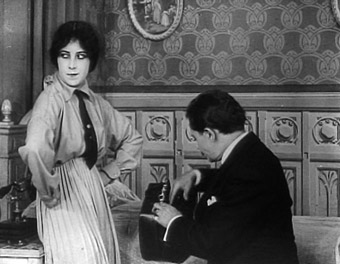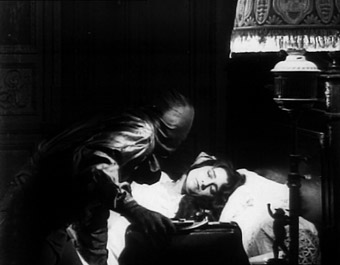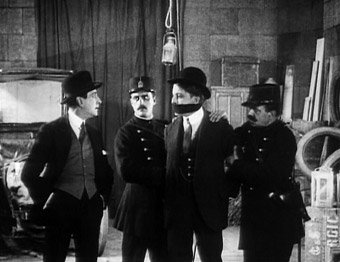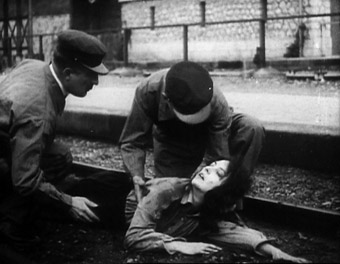Irma Vep is one of those figures who, like Louise Brooks' Lulu, I became fascinated by long before I saw a frame of film in which she appeared. I had only a single publicity photo to go on, but it was one that made an immediate and thumping impression. You can see it, tinted red, on the front cover of the Image Entertainment US DVD release of the series under discussion here. Retrospectively I can appreciate it as the result of an adolescent fascination with women of the silent cinema era who fitted the description of vamp. I know for a fact that if the goth look had been around during my school days I'd have been following women around all day with my eyes and possibly tongue hanging out.
Les Vampires was a 10-film serial made in 1915 by Louis Feuillade, the man responsible for the revered Fantômas series of the previous year and one that again pitted the representatives of law, order and decency against master criminals who were bursting with evil intent. Fantômas's Inspector Juve is here replaced by crusading reporter Philippe Guérande, who appears to have made the investigation and eventual exposure of the criminal gang known as The Vampires his life's work. The Vampires are commanded by a figure known as The Grand Vampire, but their most enigmatic member by far is Irma Vep, a woman as ruthless and deadly as she is beautiful.*
Over the course of the ten films, the relationship between The Vampires and Philippe develops into a mutual and personal hatred of one another. Initially an annoyance for the information he has collected on the gang and a coded notebook that falls into his possession, Philippe becomes a marked man after he is repeatedly instrumental in the foiling of the Vampires' plans, while his determination to destroy them is cemented when they murder his rumoured bride-to-be.

Although in some ways stylistically similar to the Fantômas series, Les Vampires aligns itself from the start with the good guys and presumes we'll do likewise, an assumption it rewards by allowing Philippe and his associates to repeatedly outwit the criminal gang of the title. While this doubtless worked a treat for a 1915 audience and may well still for those who believe that good should always triumph over evil, for this slightly more cynical viewer it lacks the daring and darker appeal of the Fantômas films, in which the villain repeatedly escaped to kill another day. It's not some twisted morality on my part (at least I don't think it is...) but a recognition that in these films, as in so many great genre works, the bad guys are far more interesting than the supposed heroes. Philippe is an energetic but otherwise dull leading man who plays repeated second fiddle to his friend and accomplice Mazamette, a sort of French James Finlayson with an eye for the ladies and a fourth-wall-busting habit of tossing knowing looks or even words at the audience.
Mazamette is obviously designed as the series' comedy relief, and while in the silent movie tradition, he's still played less broadly than the more boisterous creations of the Sennett studios. None of which is a problem. My real issue with him is his status as a kind of walking dues ex machina – every time someone's in trouble or a clue to a villain's hideout is momentarily exposed or a devilish plan is going too well, then Mazamette is there, waiting behind a curtain, concealed in a packing case, or just co-incidentally passing by. Once or twice I'd have bought it, no trouble, but by the tenth or twelfth time you start to suspect that Feuillade had spent all his time dreaming up ways of landing his characters in the soup but had expended no thought at all on how to get them out of it.
The series is at its best in the first two-thirds, when narratives are more inventive and we get to enjoy The Vampires and their rival Juan Jose Moréno doing their thing, at least until foiled by Philippe and Mazamette, or even each other. The series peaks in episodes 4 through 7, when the plotting intensifies and the criminals are at their murderous best – later things are simplified to allow the bad guys to devote the lion's share of their energy to doing away with Philippe and his nearest and dearest.
Perhaps unsurprisingly, the the films are composed largely of static shots, many of them held for considerable length to record conversations whose content is communicated chiefly through low-key mime. But there are still signs that Feuillade was developing his craft, with a solid use of close-ups for clarity and emphasis, and car mounted cameras to follow characters or vehicles in motion. His cinematic foresight hits a brief but interesting peak in Episode 7, where the observation of a key signature being written is emphasised by what looks like a brief but brisk dolly in, a shot more readily associated with later sound cinema and that is still in widespread use today.

A fondly remembered and influential series, Les Vampires may not have worn as well as Feuillade's darker, more surrealistic Fantômas films, but once it gets going it proves surprisingly addictive, despite the tendency to hand unlikely victory to the least interesting and most self-righteous characters. To give a more detailed flavour of how the series develops I've looked at the splendidly titled episodes individually – there are some spoilers here and if you want to go in cold then you might want to give this bit a miss.
Episode 1: The Severed Head (30:49)
The series gets off to an intriguing start with some scene-setting that introduces us to Philippe Guérande, dynamic reporter at le Mondial, and his quest to expose The Vampires, who for this first film remain teasingly shadowy figures. The publicly announced arrival in town (this happens several times during the series) of wealthy American Margaret Simpson and her fabulous jewels inevitably attracts the attention of the gang, a black clad member of whom raids Mrs. Simpson's bedroom at night in a sequence that has future echoes of the bedroom visitations of Nosferatu and Dracula, creatures of the gang's namesake. We are also introduced to Philippe's kindly old mum, and Philippe has his first dealings with Mazamette and the crime lord known as The Grand Vampire.
Episode 2: The Killer Ring (13:06)
The shortest episode by some degree provides Philippe with some serious motivation to hunt out The Vampires when they target his fiancé, the famed dancer Marfa Kontiloff, who is starring in a ballet entitled – who'd have thought it? – Vampires. Philippe gets kidnapped by the gang, the first of several successful such attempts, and Mazamette effects his first of his many "I just happened to be here" interventions.
Episode 3: The Red Cypher (37:52)
A notebook recovered from the body the Grand Inquisitor of Vampires that rather foolishly details the crimes of the gang (and then optimistically warns against reading it) has come into Philippe's possession. He asks for an article to be put in the paper announcing the temporary suspension of his investigations due to illness, then demonstrates his good health to the audience by leaping out of bed and exercising with weights. It's all a ruse to fool The Vampires, of course, who are watching his house and immediately take the bait.

It's here we are finally introduced to Irma Vep (hoorah!), who's performing at the splendidly named Hissing Cat Club, the basement of which is a meeting place for the Vampires, who are obviously way more fun than the prissy Philippe. Gang bigwig Comte de Noirmoutier sets a plan in motion to retrieve the notebook, one that involves installing Irma in Philippe's house as a maid and kidnapping his mum, but good guy help is at hand from an object given to Philippe by, you've guessed it, Mazamette. In a neat bit of animated visualisation of reasoning, Irma Vep's name is shown to be an anagram of 'vampire'. But you knew that, didn't you?
Episode 4: The Ghost (29:29)
The plot complicates and the pace picks up as businessman Juan Jose Moréno approaches estate agent Treps, who unbeknown to him is a head Vampire who uses his position to fleece potentially wealthy clients. Moréno's looking for an apartment containing a safe and Treps finds him one with a false rear wall that allows access from the neighbouring property, where Irma and he are lying in wait. But when they open the safe they find not money or jewels, but evidence that Moréno is himself also a criminal, probably from their own organisation. What they don't realise is that he is actually the head of a rival criminal gang and as potentially problematic for them as the police.
The main story involves Monsieur Métadier, a man who has been charged with the job of transporting 300,000 francs to Roen in the employ of a bank bank in which Irma is masquerading as a secretary. He never completes his journey, as Irma and her colleague kill him en route. Imagine their surprise, then, when he turns up at the bank later as if nothing had happened.
The explanation for all this is intriguing and satisfying and the story is well told. The episode is also handled with more technical aplomb than its predecessors – a slow pan past a dividing wall to reveal Irma's presence and a split-screen phone call are particularly memorable, and there's even a flashback when Moréno explains how he came across Métadier's body. There's also an increased sense of the macabre, with a corpse wrapped and stuffed in Moréno's safe, and the banker's nasty murder at Irma's hands accompanied by the intertitle "A good use of hatpins."
Episode 5: The Dead Escaping Man (34:28)
Although not without its share of long, single-shot sequences in which characters explain something to someone else, this is another lively episode with a number of memorable moments. The chief would-be surprise is given away in the title, as Moréno is hauled before the magistrate and promptly commits suicide with a concealed cyanide pill. Of course it's all a ruse on his part, as an unfortunate prison guard finds out when he rises from the dead (a nicely creepy image) and throttles him, stealing his uniform and making good his escape.

Philippe gets kidnapped by the Vampires again, this time in spectacular fashion (you really have to see this one), then by the cocksure Moréno, who threatens to hang the reporter unless he aids him in his vengeance against the Vampires. Wealthy locals are invited to a party and gassed for robbery in a standout scene, while the camera goes on the move when it follows a car on which Moréno is perched as he looks to rob the robbers. The conveniently located Mazamette is once again on hand to get Philippe out of trouble.
Episode 6: The Hypnotic Gaze (52:27)
Philippe and Mazamette discreetly nip off to Fontainbleau to do some nosing around and spy American tourist Horace Werner concealing a box in the forest. Back at Werner's hotel, the Grand Vampire – who's disguised as someone named Compte de Kerlor – links Werner and his wife to a $200,000 robbery and starts planning how he'll get his hands on their loot. Things seem to be going to plan, but little does he know that rival villain Moréno is also at the hotel and not only intends to grab the loot from the Vampires, but kidnap Irma and hold her to ransom for good measure.
The running time increases but this doesn't result in more complex plotting, at least when compared to Episode 4. Enjoyable nonetheless, not least for Irma in her all-blacks, but animal lovers might want to give this one a miss – a visualised story related by de Kerlor involves what looks very like the on-screen killing of two bulls. Ends intriguingly with a change of social status for Mazamette and a question mark over Irma's future following... ah, but that's not for me to reveal.
Episode 7: Satanas (41:19)
Here we get to meet the true Grand Vampire in the shape of the ruthless Satanas, who pops in to paralyse Moréno and suggest he fall in behind him or face the consequences. He's a man with the power to back up such a threat, too, as he keeps an artillery cannon concealed in his apartment and can target distant buildings to within a few feet without alerting the neighbours of the shell's source. In an interesting technological touch this cannon has to be wired to the electricity supply to operate.
Another newspaper story about another visiting wealthy American attracts immediate Vampire attention, and Irma works with fellow femme fatale Fleur-de-Lys to charm the old fool of his signature and voice in a rather neatly executed if improbable plan. It shows all the signs of working until Mazamette just happens to visit the bank at the same time as Fleur-de-Lys...
Episode 8: The Thunder Lord (48:49)
A plan to release an imprisoned Vampire is set into motion that will kill many to free one. Wow these guys are bad. Animated lettering is once again inventively used, this time to illustrate the reading of a coded message, and the idea that invisible ink can be read by warming a Vampire note between praying hands puts a pleasingly dark spin on a religious ritual.

It's a neat enough narrative that's scuppered a little by yet another of Mazamette's chance encounters and a further just-in-time appearance to save the day. He's even got his young son to help him this time, a cocksure little brat who's been thrown out of school and appears to be learning his father's trait of winking at the audience. Oddly enough this is the only episode he's in.
Irma's triumphant return to the Hissing Cat Club is an episode highlight, while an illustration of how things have changed in the acting profession is provided by the unnerving image of Musidora, the actress who plays her and an acrobat by trade, lying under a train as it pulls away. A lovely intertitle has her explain her ragged condition to the station staff and police as "a timeless tale of star crossed lovers to which simple souls are so partial." A brilliant chemist named Venomous is the gang's new boss.
Episode 9: The Poison Man (47:41)
From now on it's The Vampires vs. Philippe Feuillade, who's looking to marry Jane Brémontier, which makes you wonder how serious he was about poor departed Marfa. Venomous and his crew go after them at their engagement dinner, first with poisoned champagne, then by spaying their car with toxins, but guess who's hiding in the trunk on the vehicle's side? The pace is brisk and there are some well done travelling shots in an enjoyable chase, but as for the ending...
Episode 10: Marriage of Blood (55:07)
The final act is briskly staged but a tad depressing for those of us rooting for Irma and the boys, as by now it's clear that the good guys are likely to win and they simply don't deserve to. For the second time in the series the gang kidnap someone by hauling them neck-first from an upstairs window and just once more Mazamette gets to foil their plans. Irma's impending marriage is marked by an 'orgiastic' celebration that confirms beyond all doubt that Irma's gang is the one to be in, if only to help to bring the insufferably smug Philippe and Mazamette to their worthless knees.
Les Vampires was made in 1915, over 90 years ago and not that long after the birth of cinema as an entertainment medium. It's thus a little unreasonable to expect a pristine print, even after the restoration work that has clearly been carried out here. Damage, dust and scratches are still very visible and worse on some episodes and scenes than others (episode 8 is a notable for this), but in other respects the transfer is far better than you'd expect for film elements of this distant vintage. Detail in particular is very good and at its best the contrast is nicely judged. The sort of frame jitter often associated with films of from the mid-silent period is almost completely absent.

The music score by Eric Le Guen and Chateau Flight has to cover a considerable running time and unsurprisingly there's an extensive re-use of recognisable themes, but it's never obtrusive in a negative way and at best very effective, particularly when dealing with sinister scenes or creating an atmosphere of threat. The sound quality itself is fine and the track is encoded in Dolby 2.0 stereo.
You'd be forgiven for expecting no extras given the overall running time of the series, but Artificial Eye have included five short films by Louis Feuillade, a man responsible for directing almost 800 films in his dizzyingly prolific career. Cinematically they are quite basic, as are the narratives, although the brisk pace of The Awakening of the Artist and the trick photography of The Legend of the Spinner effectively demonstrate a variety in Feuillade's style.
The films are detailed individually below.
The Roman Orgy / L'Orgie Romaine – 1911 (8:14)
A warning to tyrants everywhere. In just 8 minutes and 6 camera set-ups, Feuillade shows us the decadence, cruelty and downfall of Emperor Heliogabalus, "the Serdanapalus of Rome." The just off-screen violence includes a slave fed to lions and a beheading. A tinted monochrome print.
The Awakening of the Artist / Le réveil de l'artiste (aka C'est pour les orphelines / This is for the Children) – 1916 (2:12)
A short, not that funny gag involving a waking actor and a moment of inspiration whose editing and performances nonetheless bristle with energy. The cast is made up almost exclusively of actors from Les Vampires, with Marcel Lévesque (Mazamette) in the lead. The print has plenty of damage, but still looks pretty good for its age.
La Bous-Bous Mie – 1909 (7:20)
Another single gag film but a rather engaging one. The title refers to a fashionable new dance that the jovial and well-rounded Madame Ducordon becomes obsessed with after seeing it performed on stage, and her enthusiasm infects just about everyone she comes in contact with (including the two policemen who escort her out of the theatre). There's no music score on this one.
The Legend of the Spinner / La Legend de la fileuse – 1908 (7:59)
A stage-bound but still inventive story of the goddess Athena's jealousy of weaver Arachne's skills and the muse who comes to Arachne's aid when she's damned first to Hades and then to the lair of Posiden, only to end up meeting a fate that befits her name. The camera angles are limited to theatrical wide shots, but there's some interesting Méliès-style trick photography to make demons (clearly humans with sheets over their heads, but that's beside the point) disappear and transport Arachne back to earth. Her roll-along-the-floor descent to the ocean depths has a particular low-tech charm.
A Very Fine Lady / Une Dame vraiment bien – 1908 (4:05)
The stuff of modern cosmetic and deodorant commercials, this comic short is essentially a series of gags and pratfalls that result from men watching the fine lady of the title instead of what they're doing or where they're going. Again this is music-free.
There is also a brief biography of Louis Feullade.
I should point out that the cover artwork supplied with the review discs also claims the inclusion of a 32 minute portrait of the director made in 1965, but either it's buried somewhere as an Easter egg or was removed at the last minute due to a rights or availability issue, assuming that the preview discs are accurate representations of the final release, and I have no reason to suspect otherwise. The same artwork does not list the inclusion of the 1909 short Le Bous-Bous Mie, which I am presuming was added by way of partial compensation.
Regarded by many as a classic serial, Les Vampires is an involving work in spite of its over-reliance on the frequent miraculous intervention of Mazamette and a largely unadventurous cinematic style. My issues with the dull heroes repeatedly winning out over people I'd happily party with are mine and mine alone, but it's this aspect for me that gives Feuillade's Fantômas series a serious edge. It nonetheless comes warmly recommended to all devotees of silent cinema, not least for Artificial Eye's 3-disc presentation of the complete series and the bonus of the five extra short films, which are intriguing in themselves.
* Her iconic status was more recently recognised by filmmaker Oliver Assayas with his 1996 film Irma Vep, which chronicled a fictional modern remake of the series in which Hong Kong legend Maggie Cheung was cast as Irma. |